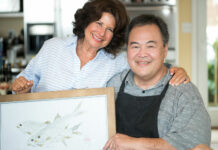
I awake to an olfactory reveille — a pungent, sweet, spicy aroma — and follow my nose to the kitchen. My husband, Jamie, a sunrise alchemist, is shaking mustard seed into his bubbling cauldron.
“Mmmm,” I murmur and lean in for a better look. Exotic spices swirl around bright orange mango, yellow ginger, raisins, brown sugar, onions and (oooeee!) vinegar — a kaleidoscope of fragrance and color.
Jamie makes the best mango chutney in Maui County. And I say that with complete modesty, because it once won Best of Show at the Maui County Fair. I remember that when Jamie collected his blue ribbon, he was two heads taller than the majority of his competition — and the opposite gender. And he was, well, haole (non-Hawaiian; in his case, Caucasian). Initially he received enough stink eye to last a lifetime when he won the prize, but after trading canning tips and talking story with the local ladies, he won them over, and they attributed him with kama‘āina (native-born) credibility.
Lately at our office, there’s been some debate over the term kama‘āina.
“The literal meaning is ‘child of the land,’ someone born here,” observed consulting editor Rita Goldman. By that criterion, then, my two sons are kama‘āina while I am not, despite having lived here for more than 45 years. Another opinion, please.
“It’s a mental state, a willingness to embrace what is already here,” says one of our writers, who arrived here at the ripe old age of two. “That’s why some people who come here are never considered kama‘āina — they never let go of how they think things should be.” Hmm, getting closer.
I ask our friend Kimokeo Kapahulehua, who is both Native Hawaiian and a respected cultural advisor. “Kama‘āina is someone who fits in,” he says.
“Do you have to be born here?” I ask.
“No, that’s kanaka,” he says. “Love the land and the people — and be respectful. That’s kama‘āina.”
Back in the kitchen, Jamie’s award-winning chutney is ready to jar. I spoon up a small taste and am rewarded with a glorious burst of flavor and bite.
“What do you think kama‘āina is?” I ask my husband as I take another spoonful.
“Maybe it’s like chutney, a blend of opposites that get into a melting pot and make it work,” he suggests.
I consider this idea — a sweet mix of foreign and local, spiked with a bit of vinegar for respect and decide it’s the perfect recipe for present-day.
My generation called America “the great melting pot,” a term that was adopted from a play of the same name first presented in 1908 and written by British author Israel Zangwill, the son of Russian-Jewish immigrants. The play celebrated America’s capacity to absorb and grow from the contributions of its many and varied immigrants who came to our shores from all corners of the Earth, “Ah, what a stirring and a seething! Celt and Latin, Slav and Teuton, Greek and Syrian, black and yellow.” President Theodore Roosevelt is said to have shouted on opening night, “That’s a great play, Mr. Zangwill!”
This year has been, and still remains, a challenging time of hardship and unspeakable loss. But as long as we remember that we’re in this together, we will get through it. Whether your name is Kapahulehua, Zangwill, Roosevelt, McGlashan, Giordani, Tadena, Speere, Barreras, Chun, Goldman, Shalhoub, or even Moonbeam … whether you are kama‘āina or malihini (foreigner, newcomer), one thing is for certain: we need each other.
At the close of our 25th year, my heart is filled with gratitude for all of you — your friendship and your readership. Mahalo nui for allowing us to share the stories of our island melting pot.
Wishing you a kama‘āina Christmas filled with sweetness and spice, respect and love. Mele Kalikimaka and happy holidays to all.
For Jessica Kealoha, a kanaka and child of the land who taught love and respect to every person she touched with every cell of her being. She lived in constant grace.
Parts of this publisher’s note were taken from our October 2009 issue.
A hui hou,
Diane Haynes Woodburn
Publisher




